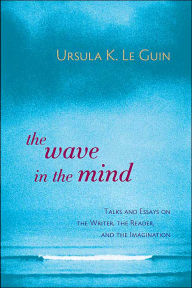Speculative fiction, magic realism, "slipstream" fiction -- all these terms could apply to the works of Ursula K. Le Guin. Unfortunately, none was in common use when she started writing in the early 1960s. As a young writer, Le Guin weathered seven years of rejections from editors who praised her novels' elegant prose but were puzzled by their content. At a time when the only literary fiction was realistic fiction, as Le Guin later told an interviewer for The Register-Guard in Portland, Oregon, "There just wasn't a pigeonhole for what I write."
At long last, two of her stories were accepted for publication, one at a literary journal and one at a science-fiction magazine. The literary journal paid her in copies of the journal; the science-fiction magazine paid $30. She told The Register-Guard, "I thought: 'Oooohhh! They'll call what I write science fiction, will they? And they'll pay me for it? Well, here we go!' "
Le Guin continued to write and publish stories, but her breakthrough success came with the publication of The Left Hand of Darkness in 1969. The novel, which tells of a human ambassador's encounters with the gender-changing inhabitants of a distant planet, was unusual for science fiction in that it owed more to anthropology and sociology than to the hard sciences of physics or biology. The book was lauded for its intellectual and psychological depth, as well as for its fascinating premise. "What got to me was the quality of the story-telling," wrote Frank Herbert, the author of Dune. "She's taken the mythology, psychology -- the entire creative surround -- and woven it into a jewel of a story."
Since then, Le Guin has published many novels, several volumes of short stories, and numerous poems, essays, translations, and children's books. She's won an arm's-length list of awards, including both the Hugo and Nebula Awards for The Left Hand of Darkness and The Dispossessed, and a National Book Award for The Farthest Shore. Over the years, she has created and sustained two fictional universes, populating each with dozens of characters and stories. The first universe, Ekumen, more or less fits into the science-fiction mode, with its aliens and interplanetary travel; the second, Earthsea, is a fantasy world, complete with wizards and dragons. As Margaret Atwood wrote in The New York Review of Books, "Either one would have been sufficient to establish Le Guin's reputation as a mistress of its genre; both together make one suspect that the writer has the benefit of arcane drugs or creative double-jointedness or ambidexterity."
More impressive still is the way Le Guin's books have garnered such tremendous crossover appeal. Unlike many writers of science fiction, she is regularly reviewed in mainstream publications, where her work has been praised by the likes of John Updike and Harold Bloom. But then, Le Guin has never fit comfortably into a single genre. As she said in a Science Fiction Weekly interview, "I know that I'm always called 'the sci-fi writer.' Everybody wants to stick me into that one box, while I really live in several boxes. It's probably hurt the sales of my realistic books like Searoad, because it tended to get stuck into science fiction, where browsing readers that didn't read science fiction would never see it."
Le Guin has also published a translation of Lao Tzu's Tao Te Ching, a book that has influenced her life and writing since she was a teenager; she has translated fiction by Angelica Gorodischer and a volume of poems by Gabriela Mistral; and, perhaps most gratifyingly for her fans, she has returned to the imaginary realm of Earthsea. Tehanu, which appeared in 1990, was subtitled "The Last Book of Earthsea," but Le Guin found she had more to tell, and she continued with Tales from Earthsea and The Other Wind. "I thought after 'Tehanu' the story was finished, but I was wrong," she told Salon interviewer Faith L. Justice. "I've learned never to say 'never.' "



















